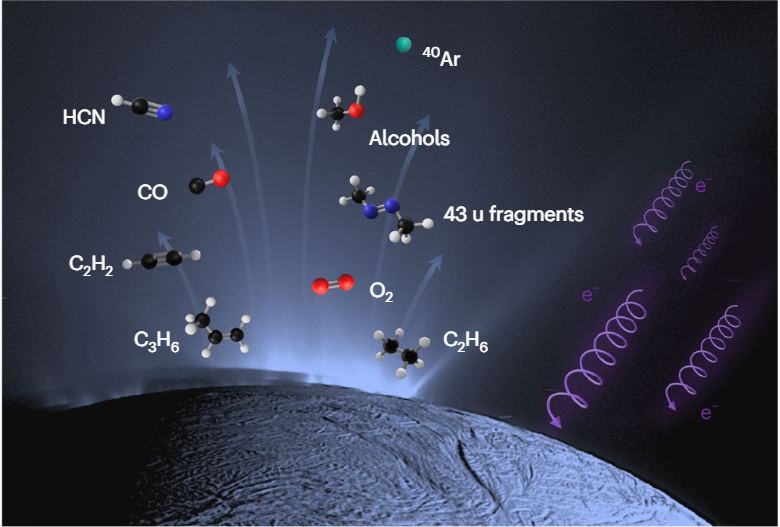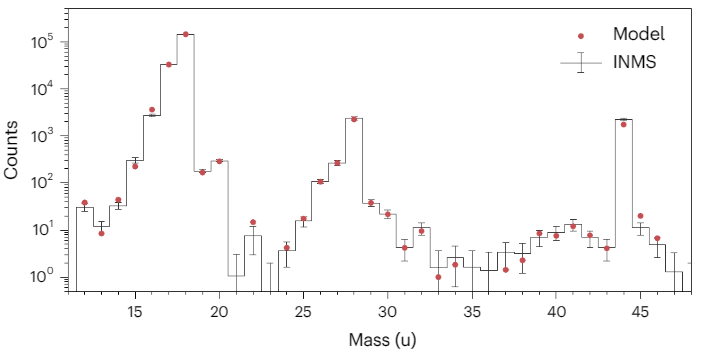Enceladus’ status as a target in the search for life keeps rising. We’ve known for years that plumes erupting from the ocean under the moon’s icy shell contain important organic compounds related to life. Now, researchers have found another chemical in the plumes which is not only highly toxic but also critical in the appearance of life.
The Cassini spacecraft spent 13 years in the Saturn system before ending its mission in 2017. Among its many discoveries were plumes erupting from Saturn’s moon Enceladus. The images of the plumes are iconic.
But what the plumes contain is what really captured scientists’ attention. Cassini found compounds like carbon dioxide, methane, water, and ammonia. It also found salts, indicating that the ocean is salty. Now, researchers working with the Cassini data have identified hydrogen cyanide in the plumes.
Most of us know that hydrogen cyanide is extremely poisonous. It played a role in one of humanity’s most heinous episodes. But hydrogen cyanide (HCN) has another side to it, one that scientists think is important for the appearance of life. It may act as a precursor to nucleic acids and amino acids.
“Our work provides further evidence that Enceladus is host to some of the most important molecules for both creating the building blocks of life and for sustaining that life through metabolic reactions,” said Jonah Peter, a doctoral student at Harvard University. Peter is the lead author of new research published in Nature Astronomy. “Not only does Enceladus seem to meet the basic requirements for habitability, we now have an idea about how complex biomolecules could form there, and what sort of chemical pathways might be involved,” added Peter.
 Saturn’s moon Enceladus isn’t just bright and beautiful. It has an ocean under all that ice that has chemicals necessary for life. This image shows the moon’s southern region, including the ‘Tiger Stripes’ feature, the four roughly parallel streaks on the left of the image. This is where the plumes originate. Image Credit: NASA, ESA, JPL, SSI, Cassini Imaging Team
Saturn’s moon Enceladus isn’t just bright and beautiful. It has an ocean under all that ice that has chemicals necessary for life. This image shows the moon’s southern region, including the ‘Tiger Stripes’ feature, the four roughly parallel streaks on the left of the image. This is where the plumes originate. Image Credit: NASA, ESA, JPL, SSI, Cassini Imaging TeamAmino acids are important building blocks of life. They’re the basic unit of proteins, which are long chains of amino acids. There are over 500 hundred proteins in nature, but there are only 22 that are part of the genetic code. HCN is extremely versatile and plays a role in all amino acids, so its presence in Enceladus’ oceans is intriguing.
“The discovery of hydrogen cyanide was particularly exciting because it’s the starting point for most theories on the origin of life,” Peter said.
Scientists have been working with Cassini’s data for years, but previous investigations into the plumes didn’t show any HCN. “The most recently published list of neutral gas species confirmed in the plume consists of only H2O, CO2, CH4, NH3 and H2,” the authors write in their paper.
Determining what chemicals Cassini sensed in Enceladus’ was the job of the Ion and Neutral Mass Spectrometer (INMS), an important part of Cassini’s instrument suite. There are only small amounts of some of these chemicals, and they’re difficult to differentiate in the INMS’s data. “Difficulty in resolving minor plume constituents stems from the large number of plausible compounds relative to the low mass resolution of INMS.”
Scientists take the data from INMS and try and match it with models of known chemicals and ratios. That’s complex work. “Models of INMS spectra suffer from an additional complexity in that the signals produced by individual molecules are not necessarily linearly independent,” the authors explain. “As such, there may be multiple different combinations of species that appear to fit the data equally well.”
That means it took some sleuthing to find the HCN. And no matter how hard the researchers tried to find an alternative explanation for what they saw, they couldn’t.
“There are many potential puzzle pieces that can be fit together when trying to match the observed data,” Peter said. “We used math and statistical modelling to figure out which combination of puzzle pieces best matches the plume composition and makes the most of the data without overinterpreting the limited dataset.”
 This figure from the study helps illustrate the significance of HCN in Enceladus’ plumes. The plume of ejected material contains organic molecules with varying oxidation states. Electrons bombard the moon’s surface, and they could help facilitate the production of prebiotic molecules in the plume. These molecules, including HCN, could form nucleic and amino acid precursors that lead to the origin of life. Image Credit: Peter et al. 2023.
This figure from the study helps illustrate the significance of HCN in Enceladus’ plumes. The plume of ejected material contains organic molecules with varying oxidation states. Electrons bombard the moon’s surface, and they could help facilitate the production of prebiotic molecules in the plume. These molecules, including HCN, could form nucleic and amino acid precursors that lead to the origin of life. Image Credit: Peter et al. 2023.“The more we tried to poke holes in our results by testing alternative models,” Peter added, “the stronger the evidence became. Eventually, it became clear that there is no way to match the plume composition without including hydrogen cyanide.”
 This figure from the study shows how Cassini’s INMS data matches the team’s model, which includes the presence of HCN. Image Credit: Peter et al. 2023.
This figure from the study shows how Cassini’s INMS data matches the team’s model, which includes the presence of HCN. Image Credit: Peter et al. 2023.The discovery of HCN in Enceladus’ plumes is important because it’s kind of like a ‘Swiss army knife’ of prebiotic molecules. Its versatility means it can be assembled in many different ways, leading to the development of many different amino acids. “HCN polymerization is implicated in a number of potential pathways for the formation of nucleobases and amino acids,” the researchers write in their paper.
There has to be some feedback between the plumes and the ocean for the HCN to work its chemical magic. Material from the ocean can be deposited on the icy surface, where it is subjected to photochemical processing. If there’s enough UV striking some of these materials, then the HCN and other components of the plumes could produce RNA and amino acid precursors. Then these newly-produced chemicals could work their way back through the ice to the ocean.
Scientists don’t know for certain if that’s happening. “Whether this type of chemistry is efficient under Enceladus-like conditions could be explored in future experimental studies,” the researchers explain, “while more detailed examination of Enceladus’ oceanic material will require future robotic missions.”
While finding HCN at Enceladus is an exciting development, it’s not all the researchers found.
Previous research found carbon dioxide, methane, and hydrogen in Enceladus’ plumes. Together, they suggest that methanogenesis is taking place in the moon’s ocean. Methanogenesis is the metabolic process that produces methane, and methanogens are the life forms that perform methanogenesis. Methanogenesis is common on Earth and only takes place in low-oxygen environments. Methanogens originated on early Earth, and finding these chemicals at Enceladus suggests that primitive methanogens could be active in the moon’s ocean.
But in this new research, Peter and his co-researchers found an array of oxidized compounds. This indicates that oxygen is active in the ocean and that there are different energetic pathways life could be using. Life forms that use oxygen have far more energy at their disposal than ones that rely on methanogenesis.
“If methanogenesis is like a small watch battery, in terms of energy, then our results suggest the ocean of Enceladus might offer something more akin to a car battery, capable of providing a large amount of energy to any life that might be present,” said JPL’s Kevin Hand, co-author of the study and principal investigator of the effort that led to the new results.
Enceladus is becoming a more and more intriguing place. Its chemistry suggests that there’s everything needed for life in the moon’s ocean. There may already be life present. “In aggregate, the results presented here indicate that Enceladus is host to a multiphasic and compositionally diverse chemical environment that is consistent with a habitable subsurface ocean,” the authors write.
But there’s still a lot we don’t know. So while these results are fascinating, a deeper understanding is still beyond our reach.
We need a mission to Enceladus.

